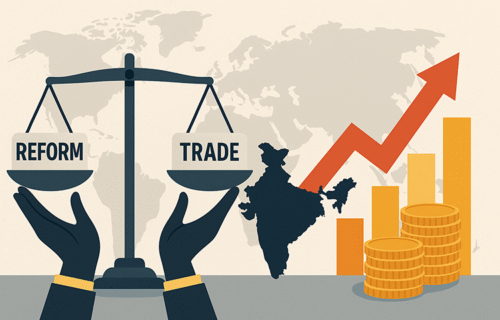India enters FY 2025/26 with solid momentum but a more challenging backdrop. Official estimates put real GDP growth for FY 2024/25 at 6.5%, with the March quarter expanding 7.4% year-on-year. That sets a high base for the current year, but also highlights the difficulty of sustaining growth consistently above 7%.
Price pressures have largely eased. Headline consumer price inflation was reported at 2.07% year-on-year in August 2025, up slightly from July, driven by food and staple costs. This remains within the Reserve Bank of India’s target band, offering policymakers some breathing space.
The government has sought to strengthen domestic demand through structural reforms. A major Goods and Services Tax overhaul will reduce the number of slabs to two—5% and 18%—with a separate 40% rate for products such as tobacco and sugary drinks. The move, expected to be phased in this autumn, is aimed at simplifying compliance and stimulating consumption. At the same time, the Union Budget 2025 raised the effective zero-tax threshold in the new income tax regime to ₹12 lakh, boosting disposable incomes for salaried households.
External risks, however, have intensified. The United States raised tariffs on Indian goods to 50% in late August, casting uncertainty over export prospects and weakening the rupee. Analysts suggest this could trim GDP growth by up to 0.3 percentage points this fiscal year, even as domestic tax cuts provide some offset. Indian exporters are already pivoting toward markets in the European Union, the UK, and Africa to reduce reliance on the US, though trade diversification will take time.
Urban consumption, a key driver of recent growth, has slowed in recent months, while rural incomes have been hit by severe floods in states such as Punjab and Himachal Pradesh. A weaker rupee has provided some relief to exporters but also raised costs for industries dependent on imported inputs. Combined with geopolitical tensions and a volatile global economy, these factors could weigh on India’s near-term resilience.
The government’s reforms may cushion the blow, but they come with limitations. Reducing indirect taxes and raising disposable incomes can support spending in the short term, yet they also strain government finances, widening the revenue deficit. Sustained gains in consumption will depend on job creation, rural recovery, and broader credit access, not just tax relief.
For India to meet its ambition of becoming the world’s third-largest economy by 2029, reforms must be paired with greater export diversification, trade deals with Europe and South America, and continued investment in logistics and infrastructure. Domestic reforms are a welcome step, but on their own they cannot insulate the economy from global headwinds.
© 2025 www.cijeurope.com
